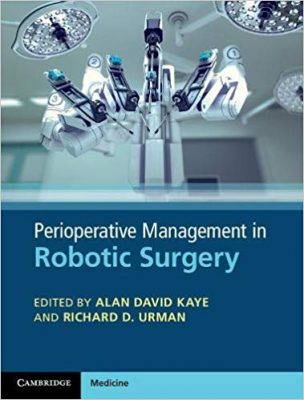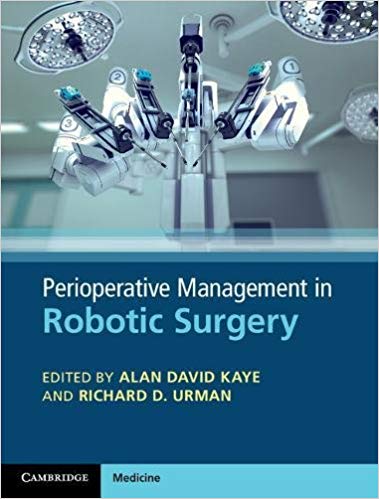 Editors: Alan David Kaye and Richard D. Urman
Editors: Alan David Kaye and Richard D. Urman
Publisher: Cambridge University Press – 268 pages
Book Review by: Nano Khilnani
Robotic surgery, sometimes called ‘robotic assisted surgery’ or RAS for short, is a method of treating patients that has many advantages over traditional surgery done by humans
Before enumerating those advantages, readers take note: robotic assisted surgery is being increasingly used now. Curious to know how many books on robotic surgery could be found on Amazon, we guessed that no more than a couple hundred would be displayed.
To our amazement, we got a count of 896 books with the phrase ‘robotic surgery’ and ‘RAS’ in the book titles
Here are advantages of robotic assisted surgery, as mentioned by the editors in the Preface
- It provides a binocular and stereoscopic view of the surgical field
- It masks surgical tremor by filtering hand movements
- It allows 360-degree movements of the instruments, mimicking open surgery
- It has the potential of single port-site surgery
- It has the potential of adding many surgical subspecialties
This book also covers the perioperative considerations for robotic-assisted surgery, including preoperative, intraoperative, and postoperative management of the patient.
Fifty-one specialists in various branches of medicine from all around the United States and one from Brazil – authored 22 chapters of this book that we list below:
Introduction: The Surgeon’s Perspective on Robotic Surgery
- Historical Overview of Robot-Assisted Surgery
- Credentialing for Robotic Surgery
- Robotic Technology
- Physiologic Effects of Pneumo-peritoneum and Positioning
- Consideration in Patients with Comorbidities, Pregnant and Pediatric Patients
- Anesthetic Considerations for Robotic-Assisted Surgery
- General and Colorectal Robotic Surgery of the Abdomen and Pelvis
- Gynecology Robotic Surgery
- Robotic Urological Surgery
- Anesthetic Considerations in Robotic Cardiac Anesthesia
- Robotics in Thoracic Surgery 1: Pulmonary and Mediastinal Disease
- Robotics in Thoracic Surgery 2: Benign and Malignant Esophageal Disease
- Transoral Robotic Surgery: Applications in the Management of Benign and Malignant Diseases of the Pharynx
- Robotic Technology in Neurosurgery: Past, Present, and Future Perspectives
- Organ Transplant and Robotic Surgery: A Comprehensive Overview
- Surgical Considerations for Organ Transplantation and Robotic Surgery
- Fetal Surgery and Robotic Surgery
- Perioperative Complications of Robotic Surgery
- Pain Management and Recovery after RAS
- Technical Skills Training and Simulation
- Understanding the Market Forces and Opportunity Costs of Robotic Surgery
- The Past, Present, and Future of Robotics: A Surgical and Aesthetics Perspective
To the delight of those readers who are desiring to learn about robotic surgery without having to go through large, thick texts with a lot of complex and overwhelming amount of information contained in them, this book
- Addresses preoperative evaluation and patient selection
- Basically has just 268 pages, bur is filled with diagrams, figures, tables
- Covers complications and common emergencies
- Describes the basics of various procedures
- Entails no complicated learning, just practice to develop basic robotic skills
- Fills the gaps inherent with some human surgical tasks
- Goes a long way in getting you started with robotic-assisted surgery
This book is simply just the right one for getting into robotic-assisted surgery!
Editors:
Alan David Kaye, MD, PhD, DABA, DABPM, DABIPP is the Tenured Professor, Program Director, and chairman of the Department of Anesthesiology at LSU Health Sciences Center in New Orleans, Louisiana. He serves on a number of national committees including the FDA Advisory Board for Anesthetics and Analgesics. He is the editor-in-chief of the journal Pain Physician, an elected Board Director for the American Society of Interventional Pain Physicians, and serves on the American Board of Interventional Pain Physicians. He was previously an Associate National Board Examiner in Anesthesiology.
Richard D. Urman, MD, MBA, CPE is Chief of Anesthesia Services and Medical Director of Sedation for Interventional Medicine at the Brigham and Women’s Hospital Care Center in Boston, Massachusetts, and Associate Professor of Anesthesia at Harvard Medical School. He also serves as the Director of Anesthesia of the interdepartmental Center for Perioperative Research at BWH and directs the newly established Perioperative Medicine Fellowship. He has an adjunct faculty appointment as Professor (Research) at LSU – New Orleans and is the Co-Founder of the Institute for Safety in Office-Based Surgery.







